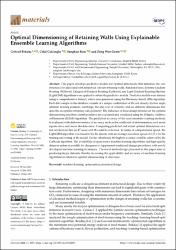| dc.contributor.author | Bekdaş, Gebrail | |
| dc.contributor.author | Çakıroğlu, Celal | |
| dc.contributor.author | Kim, Sanghun | |
| dc.contributor.author | Geem, Zong Woo | |
| dc.date.accessioned | 2022-11-10T11:59:13Z | |
| dc.date.available | 2022-11-10T11:59:13Z | |
| dc.date.issued | 2022 | en_US |
| dc.identifier.citation | Bekdaş, G., Çakıroğlu, C., Kim, S., & Geem, Z. W. (2022). Optimal Dimensioning of Retaining Walls Using Explainable Ensemble Learning Algorithms. Materials, 15(14), 4993. | en_US |
| dc.identifier.uri | https://hdl.handle.net/20.500.12846/681 | |
| dc.description.abstract | This paper develops predictive models for optimal dimensions that minimize the construction cost associated with reinforced concrete retaining walls. Random Forest, Extreme Gradient Boosting (XGBoost), Categorical Gradient Boosting (CatBoost), and Light Gradient Boosting Machine (LightGBM) algorithms were applied to obtain the predictive models. Predictive models were trained using a comprehensive dataset, which was generated using the Harmony Search (HS) algorithm. Each data sample in this database consists of a unique combination of the soil density, friction angle, ultimate bearing pressure, surcharge, the unit cost of concrete, and six different dimensions that describe an optimal retaining wall geometry. The influence of these design features on the optimal dimensioning and their interdependence are explained and visualized using the SHapley Additive exPlanations (SHAP) algorithm. The prediction accuracy of the used ensemble learning methods is evaluated with different metrics of accuracy such as the coefficient of determination, root mean square error, and mean absolute error. Comparing predicted and actual optimal dimensions on a test set showed that an R-2 score of 0.99 could be achieved. In terms of computational speed, the LightGBM algorithm was found to be the fastest, with an average execution speed of 6.17 s for the training and testing of the model. On the other hand, the highest accuracy could be achieved by the CatBoost algorithm. The availability of open-source machine learning algorithms and high-quality datasets makes it possible for designers to supplement traditional design procedures with newly developed machine learning techniques. The novel methodology proposed in this paper aims at producing larger datasets, thereby increasing the applicability and accuracy of machine learning algorithms in relation to optimal dimensioning of structures. | en_US |
| dc.language.iso | eng | en_US |
| dc.publisher | MDPI-Multidisciplinary Digital Publishing Institute | en_US |
| dc.relation.isversionof | 10.3390/ma15144993 | en_US |
| dc.rights | info:eu-repo/semantics/openAccess | en_US |
| dc.subject | Machine Learning | en_US |
| dc.subject | Optimization | en_US |
| dc.subject | Structural Design | en_US |
| dc.subject | Makine Öğrenimi | en_US |
| dc.subject | Optimizasyon | en_US |
| dc.subject | Yapısal Tasarım | en_US |
| dc.subject | Maschinelles Lernen | en_US |
| dc.subject | Optimierung | en_US |
| dc.subject | Struktureller Entwurf | en_US |
| dc.title | Optimal dimensioning of retaining walls using explainable ensemble learning algorithms | en_US |
| dc.type | article | en_US |
| dc.relation.journal | Materials | en_US |
| dc.contributor.authorID | 0000-0001-7329-1230 | en_US |
| dc.identifier.volume | 15 | en_US |
| dc.identifier.issue | 14 | en_US |
| dc.relation.publicationcategory | Makale - Uluslararası Hakemli Dergi - Kurum Öğretim Elemanı | en_US |
| dc.contributor.department | TAÜ, Mühendislik Fakültesi, İnşaat Mühendisliği Bölümü | en_US |
| dc.contributor.institutionauthor | Çakıroğlu, Celal | |
| dc.identifier.wosquality | Q2 | en_US |
| dc.identifier.scopusquality | N/A | en_US |
| dc.identifier.wos | WOS:000832006300001 | en_US |

















